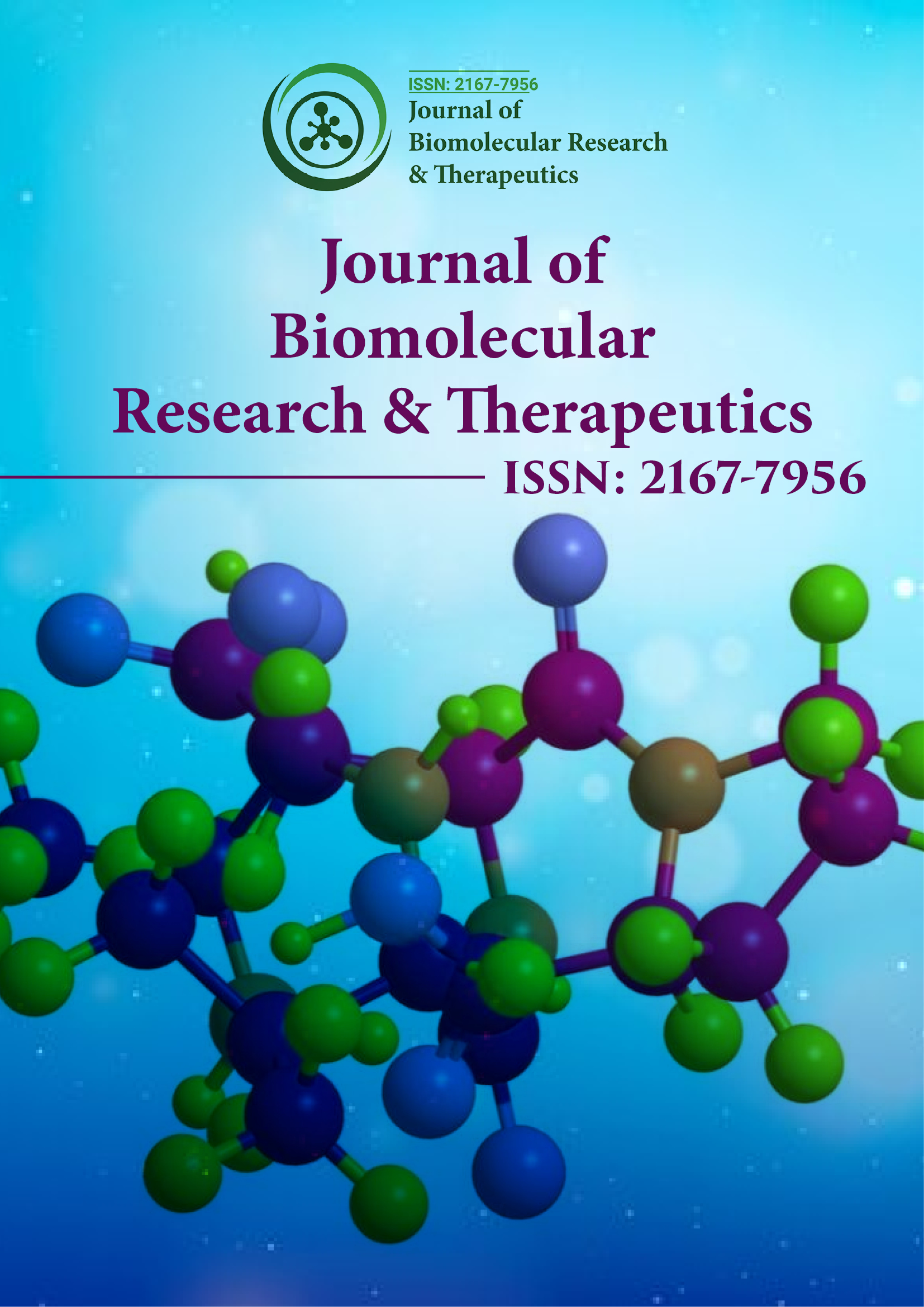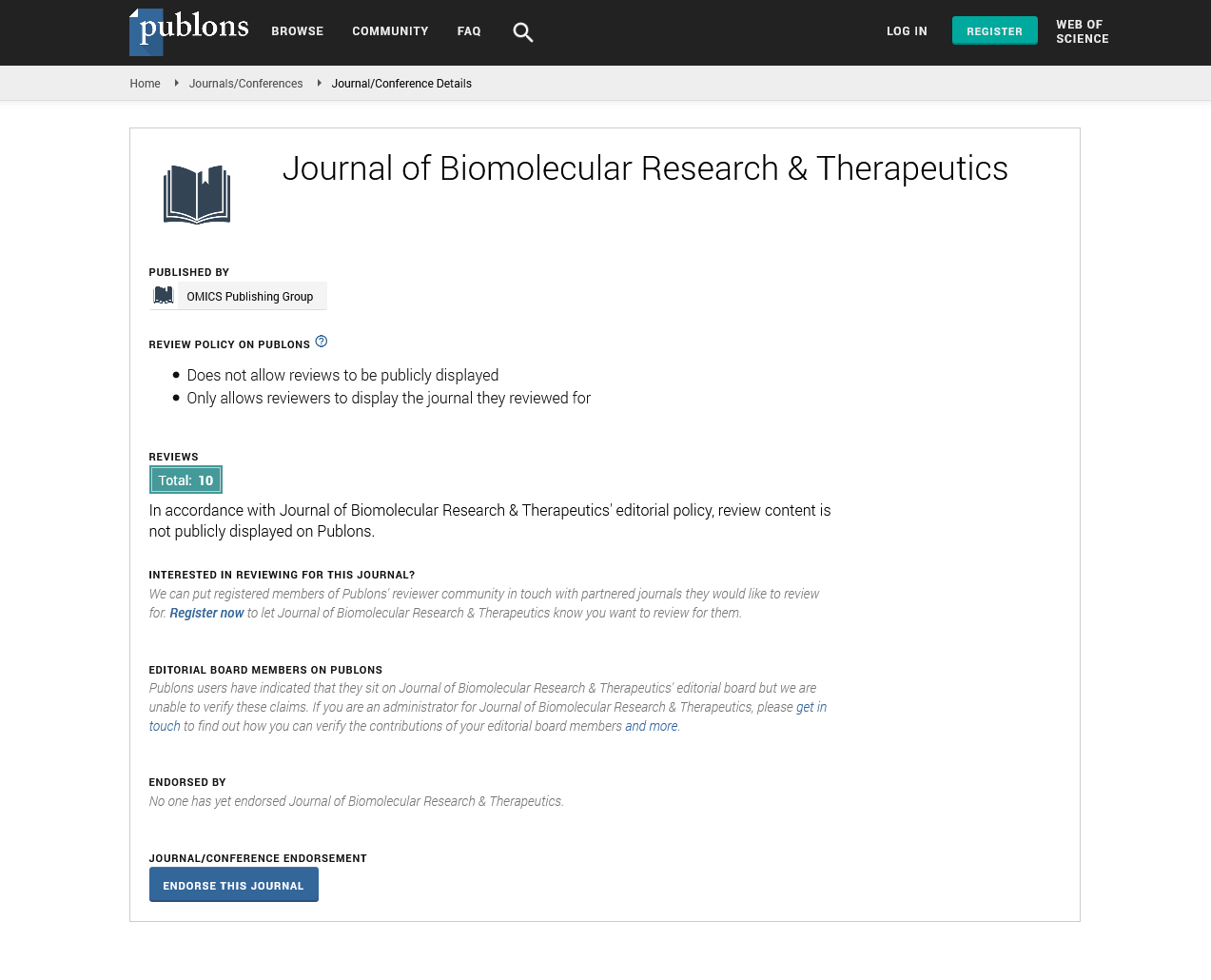Indexed In
- Open J Gate
- Genamics JournalSeek
- ResearchBible
- Electronic Journals Library
- RefSeek
- Hamdard University
- EBSCO A-Z
- OCLC- WorldCat
- SWB online catalog
- Virtual Library of Biology (vifabio)
- Publons
- Euro Pub
- Google Scholar
Useful Links
Share This Page
Journal Flyer

Open Access Journals
- Agri and Aquaculture
- Biochemistry
- Bioinformatics & Systems Biology
- Business & Management
- Chemistry
- Clinical Sciences
- Engineering
- Food & Nutrition
- General Science
- Genetics & Molecular Biology
- Immunology & Microbiology
- Medical Sciences
- Neuroscience & Psychology
- Nursing & Health Care
- Pharmaceutical Sciences
Perspective - (2024) Volume 13, Issue 1
Exploring Bio-Immobilization Strategies: Integrating Biological Entities into Functional Materials
Emily Sinclair*Received: 29-Jan-2024, Manuscript No. BOM-24-25311; Editor assigned: 31-Jan-2024, Pre QC No. BOM-24-25311 (PQ); Reviewed: 14-Feb-2024, QC No. BOM-24-25311; Revised: 21-Feb-2024, Manuscript No. BOM-24-25311 (R); Published: 28-Feb-2024, DOI: 10.35248/2167-7956.23.13.372
Description
In recent years, the integration of biological entities into functional materials has emerged as a potential avenue for various applications, ranging from biomedicine to environmental remediation. This innovative approach, known as bio-immobilization, harnesses the unique properties of biological molecules, cells, or organisms and incorporates them into matrices or substrates to enhance the functionality and performance of the resulting materials.
Bio-immobilization strategies involve the immobilization of biological entities within or onto a host material, thereby conferring specific biological functions or properties to the material. This integration can be achieved through a variety of techniques, each customized to the specific requirements of the application at hand. One of the key motivations behind bioimmobilization is the ability to exploit the inherent specificity and selectivity of biological molecules for various purposes. For example, enzymes can be immobilized onto solid supports to create biocatalysts with enhanced stability and reusability for industrial processes such as bio-catalysis and biofuel production. Similarly, antibodies can be immobilized onto surfaces to create biosensors capable of detecting target molecules with high sensitivity and specificity. In the field of biomedicine, bioimmobilization holds great potential for the development of advanced therapeutic and diagnostic tools. By immobilizing therapeutic proteins or drugs within biocompatible materials, researchers can create drug delivery systems capable of targeted and sustained release, minimizing side effects and improving patient outcomes. Furthermore, the immobilization of biological recognition elements onto implantable devices can enhance their biocompatibility and reduce the risk of rejection or infection. In addition to biomedical applications, bioimmobilization strategies are also being explored for environmental remediation and bioremediation purposes. By immobilizing microbial cells or enzymes within porous materials, researchers can create bio filters capable of efficiently removing pollutants from air or water streams. This approach offers a sustainable and cost-effective alternative to traditional remediation methods and has the potential to address pressing environmental challenges such as water pollution and soil contamination. The choice of immobilization technique depends on various factors, including the nature of the biological entity, the desired properties of the resulting material, and the intended application. Common immobilization methods include physical adsorption, covalent attachment, entrapment within porous matrices, and encapsulation within microspheres or nanoparticles. Physical adsorption involves the non-covalent binding of biological entities to the surface of a host material through electrostatic interactions, hydrogen bonding, or hydrophobic interactions.
While simple and cost-effective, this method may result in poor stability and leaching of the immobilized molecules over time. Covalent attachment, on the other hand, involves the formation of stable chemical bonds between the biological entity and the host material. This approach offers greater stability and control over the immobilization process but may require the use of chemical coupling agents and optimization of reaction conditions. Entrapment within porous matrices or encapsulation within microspheres/nanoparticles involves physically trapping the biological entities within a three-dimensional network of interconnected pores or within the core of a microsphere/ nanoparticle. This approach provides protection to the immobilized entities and allows for controlled release kinetics but may suffer from mass transfer limitations and reduced activity due to spatial confinement. In conclusion, bio-immobilization represents a versatile and powerful strategy for integrating biological entities into functional materials for a wide range of applications. By harnessing the unique properties of biological molecules, cells, or organisms, researchers can create materials with enhanced functionality, specificity, and performance, paving the way for new advances in biotechnology, biomedicine, and environmental science. One emerging trend in bio-immobilization is the development of smart materials that respond to external stimuli, such as pH, temperature, or light.
These stimuli-responsive materials, often inspired by natural systems, can undergo reversible changes in their properties or release bioactive molecules in a controlled manner. Such dynamic systems hold promise for applications in drug delivery, where targeted release of therapeutics at specific sites within the body can be achieved with high precision, minimizing off-target effects and improving patient outcomes. Furthermore, the integration of artificial intelligence and machine learning techniques is revolutionizing the design and optimization of bio-immobilized systems. By leveraging computational modelling and data-driven approaches, researchers can accelerate the discovery of optimal immobilization strategies, predict the behavior of bio-functionalized materials, and optimize their performance for specific applications. This synergistic combination of biology, materials science, and computational modelling is driving innovation in bio-immobilization and opening new frontiers in biotechnology.
Citation: Sinclair E (2024) Exploring Bio-Immobilization Strategies: Integrating Biological Entities into Functional Materials. J Biomol Res Ther. 13:372.
Copyright: © 2024 Sinclair E. This is an open-access article distributed under the terms of the Creative Commons Attribution License, which permits unrestricted use, distribution, and reproduction in any medium, provided the original author and source are credited.

